2013?
By Grant Keddie
Fish Hook shanks made of stone, bone, antler and shell are parts of composite fish hooks that are armed with a sharp bone point. These artifacts are often seen as typical “West Coast” of Vancouver Island artifacts. In fact, their distribution extends around the southern end of Vancouver Island, and to a lesser extent, north up the east coast of the Island.
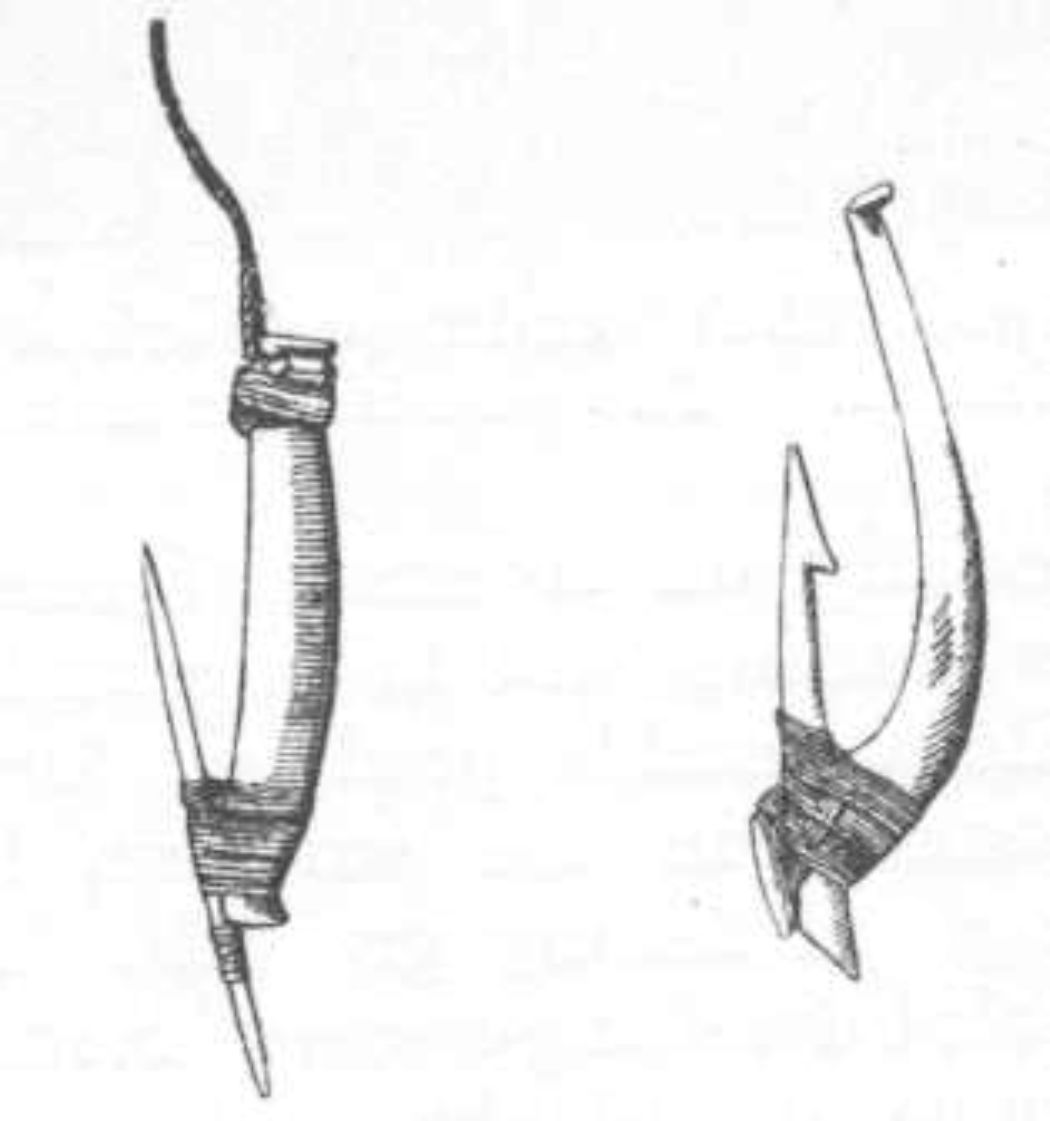
The RBCM ethnology collection has only one example of a trolling hook from the Victoria area. This specimen (number 728), however, was not one actually used. It was a model made in 1898, and purchased by Charles Newcombe. The hook was said to represent the kind of trolling hooks that local First Nation used in the past. The shank is made of wood with a small pebble attached to the proximal end. The bone selected is a small rib bone that was shaped with a steel file. Rib bones would not normally be used because they have hollow centres that are exposed if someone attempts to make a sharp point – as is the case with this one. This specimen, shown in figure 2, has a wooden shank that is 115mm long with a maximum width of 17.8mm and height of 9.3mm at the mid shaft. The distal and proximal ends are about 12mm by 7mm under the wild cherry bark wrapping. The natural metamorphic beach pebble (32.6mm X 18mm) on the proximal end is tied on by a white commercial twin or wool, which is then covered by the cherry bark, and the whole end coated in either tree sap or commercial glue. The stone weight is naturally flattened on the bottom, rounded on the sides, and wedge shaped toward the proximal end. The stone weight overlaps the wood shank by 9mm. The bone barb is 69mm long and widest (5.4mm) and highest (2.4mm) where the mid shaft meets the bark tie material. The steamers extending out from the proximal end are plant fibres – possibly stinging nettle fibres. These streamers would function to make the hook move through the water like a squid. The whole hook weights 24.37 grams.
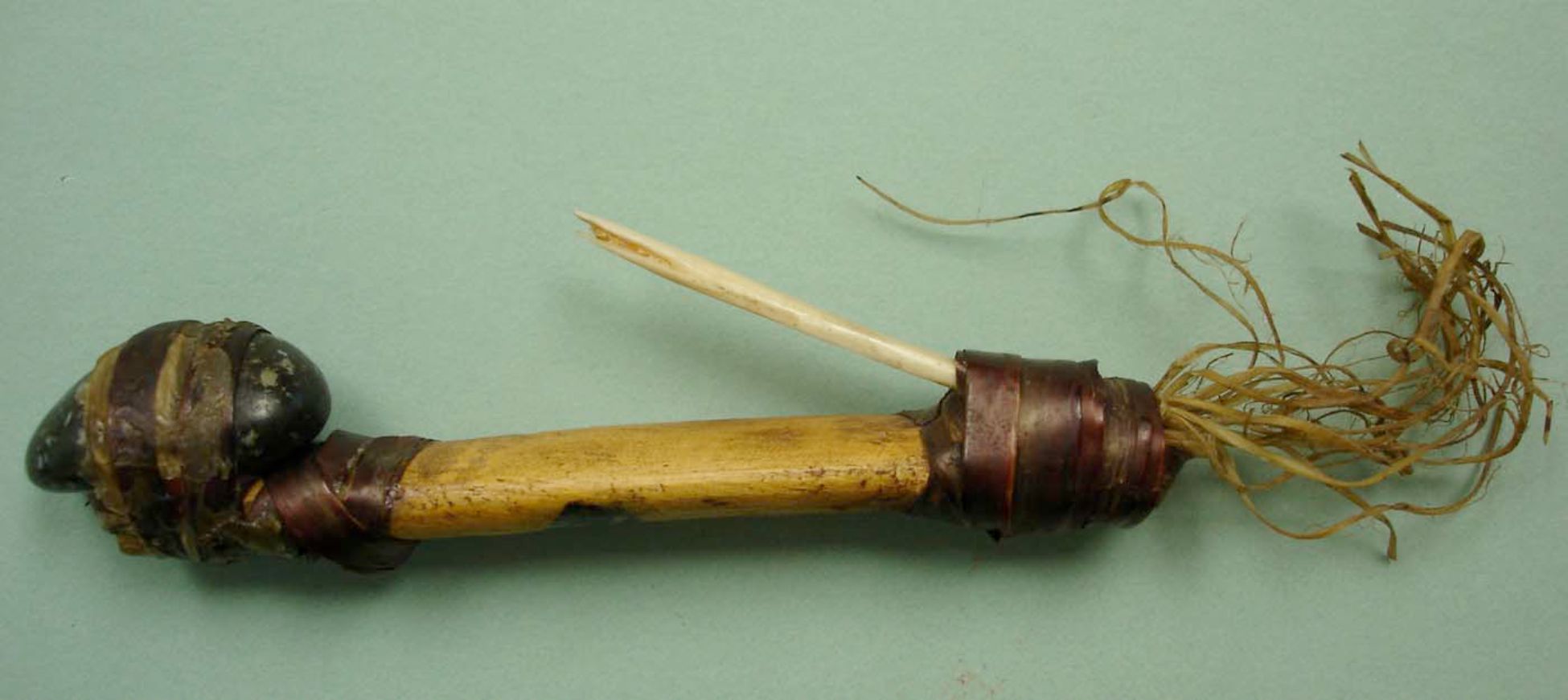
Fish Hook Shanks
Fishhook shanks generally have a long body with a rectangular-like hafting platform at the distal end, and grooves or notches for tying a fibre line at the proximal end. The platform has a single groove to accommodate the attachment of a bone point on its upper or dorsal surface or, sometimes, on a lateral surface of the distal end. This platform often has a gradual or distinct protrusion on its dorsal or lower side – to facilitate the tying of the point.
The following is a listing and description of all fishhook shanks in the RBCM archaeology collection from the south end and east coast of Vancouver Island as of August 1, 2007. Also included are some specimens from private collections documented by the RBCM, and two examples that were reburied after excavation. These are listed under the appropriate
Borden site designations. The private collection material has less information recorded – as most were not available for this study. The RBCM has a photographic record of some of them. This listing is intended as a source for the identification and comparison of these unique artifacts. Measurements here are in millimetres and weights in grams. Brackets indicate incompleteness of measurement or weight.

Fishhook Shanks in the Collection
On the south end of Vancouver Island, the earliest occurrence of stone, bone, and antler fishhook shanks is at the Pedder Bay defensive site, west of Victoria. At this site, and at other archaeological sites in the greater Victoria region, fish hook shanks date to various periods after 1800 years ago.

Pedder Bay and Rocky Point Area
There are 24 complete, fragmentary, or unfinished shanks from the Pedder Bay site DcRv-1. Three are of bone and 21 of stone. (Seven of these are from private collections). All date to after 1800 years ago.
• DcRv-1: 33. Bone. 4.1 grams. Max. L. 81mm. Distal hafting platform – max. L. 19mm; W. 5mm. H. 13mm; height of distal end 8mm; groove width 4mm. Mid-shaft: W. 4mm; H. 6mm. Proximal end tie area: three cut notches extending to 12mm.
• DcRv-i:io2. Stone. Slate? [4.6] grams. [Distal end missing] Max. L. [45.5mm]. Distal hafting platform: max L. 17.5mm, W. 5.5mm, H. 12mm; groove width 2mm. Midshaft: W. 5mm, H. 7.5mm.
• DcRv-i:235. Stone. Slate? 11.2 grams. Max. L. 65mm. Distal hafting platform: max. L 17mm, W. 6mm, H. 16mm, H. distal end 14mm; groove width 2.4mm. Midshaft: W. 7mm, H. 10mm. Proximal end tie area: One 2mm groove encircling except on base.
• DcRv-1:245. Stone. Slate? [6.5] grams. [Unfinished broken distal portion only]. Max. L. [5.1] mm, W. [5mm]. Distal hafting platform: L. 18mm, W. 4.8mm, H. 18mm. No groove.
• DcRv-1352. Stone. Slate? 6.9 grams. Max. L. 64mm. Distal hafting platform: max. L. 19mm, W. 6mm, H. 12mm. H. distal end 10.5mm; groove width 2mm. Midshaft W. 6.5mm; H. 7mm. Proximal end tie area: Two nearly encircling grooves – one with second cut on base that nearly joins to other encircling cut grooves. Short horizontal tie groove on top.
• DcRv-1: 486. Stone. Slate? [15.1] grams. [Unfinished broken proximal portion]. Max. L. [53mm]. W. [9.5mm].
• DcRv-1:5O1. Stone. Slate? 13.2 grams. Max. L. 72.5mm. Distal hafting platform: max. L. 19mm, W. 9mm, H. 13mm; H. distal end 10mm; groove width 2.4mm. Midshaft: W. 9mm, H. 11mm. Proximal end tie area: six intermittent partial grooves extending to 10mm.
• DcRv-1:508. Stone. Slate? [10] grams. [Proximal end missing] Max. L. [50.5mm]. Midshaft: W. 10mm, H. 12mm. Proximal end tie area: two nearly encircling grooves – one does not join on top and other extends to a 10mm horizontal cut groove.
• DcRv-1:574. Bone. [1.4] grams. Distal fragment only. Max. L. [27mm]. Distal hafting platform: max. L. 20mm, W. 4.7mm, H. 17mm; height of distal end 15mm; groove width 3.5mm.
• DcRv-1730. Stone. Slate? 5.2 grams. Max L. 52mm. Distal hafting platform: max L. 12mm, W. 7mm, H. 11.3mm, H. distal end: 9mm; groove width 2mm. Midshaft: W. 6.5mm, H. 7.5mm. Proximal end area: Two encircling grooves. 9mm horizontal groove on top extends across the second encircling groove.
• DcRv-1:1086. Stone. Slate? 12.9 grams. [Complete but unfinished details]. Max. L. 85mm. Distal hafting platform: max. L. 23mm, 6.3mm, H. 17.5mm. Platform groove is unfinished and exhibits two incomplete thin grooves. Midshaft: W. 7mm, H. 9.3mm. Proximal end is unfinished with two very slight start grooves.
• DcRv-1:1087. Stone. Slate? 14.3grams. Max. L. 79mm. Distal hafting platform: max. L. 19mm, W. 8mm, H. 15mm; H. distal end 11mm; groove width 2.5mm. Midshaft: W. 9.3mm; H. 10.2mm. Proximal end tie area: two encircling grooves in inset area and one intermittent incised line forward of inset area extending to 12mm. Short horizontal tie groove on top.
• DcRv-1: 1088. Stone. Slate? i5.5grams. Max. L. 87.8mm. Distal hafting platform: max. L. 18.5, W. 7.5, H. 14mm; H. distal end 11.5mm; groove width 2.5mm. Midshaft: W. 8mm, H. 10mm. Proximal end tie area: three notches in inset area with two tiny incisions forward of inset extending to 12mm.
• DcRv-i:io9o. Stone. Slate? [5] grams. [Distal end missing]. Max. L. [45.5mm]. Midshaft: W. 6.5mm, H. 10.5mm. Proximal end tie area: the upper or ventral surface is inset 2.5mm for a distance of 7mm. Two grooves nearly encircle this end – except the top.
• DcRv-1: 2103. Stone. Slate? [29.3] grams. [Unfinished]. Piece of split slate ground to a rounded surface for 27mm at what would be the proximal end. There is some slight pecking on parts of the unfinished surface. Max. L. 86mm, W. 13mm, H. 17mm.
• DcRv-1:2219. Stone. Schistlike material? [2.3] grams. [Distal end missing]. Max. L. [37mm]. Midshaft: W. 6mm, H. 6.3mm. Proximal end thins out for 9mm – with small downward protrusion at the tip. There are no notches or grooves on the proximal end.
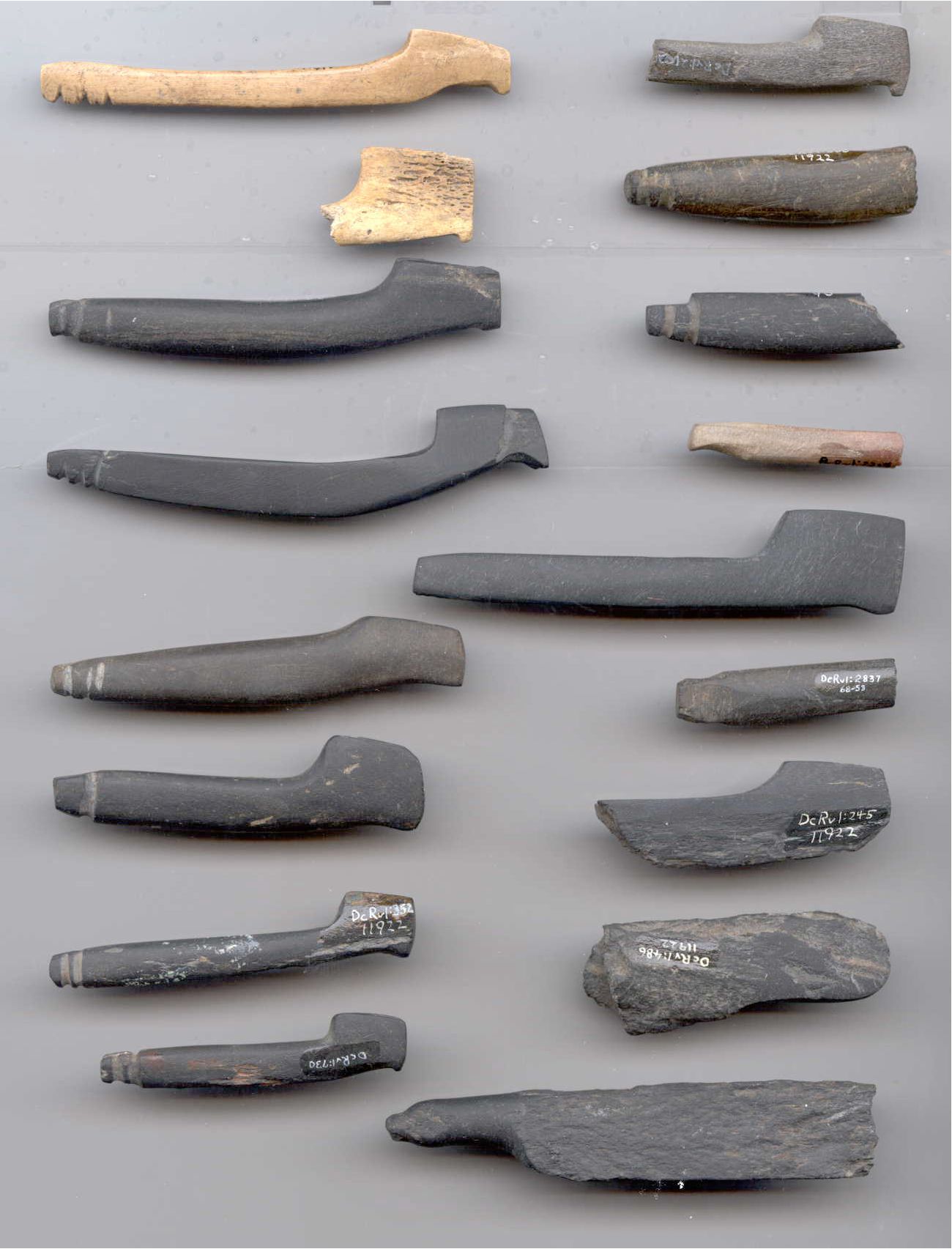
• DcRv-1:2837. Stone. Slate? [5.4] grams. [Distal portion missing]. Midshaft: W. 7mm, H. 9mm. Proximal tip is thinned 1.5mm in width and height for 9mm. Groove on upper and lower surface of thinned area at tip. 730.
• DcRv-i:597. Stone. Private Collection.
• DcRv-i:72i. Stone. Complete. [old measurements proximal end L. 6.46 and W. 1.33; shaft 1.2X0.62]. Private Collection.
• DcRv-1722. Stone. Distal end only. [old measurements max. L. 4.29; L. of platform area 1.65mm; Shaft 1.01X.74]. Private Collection.
• DcRu-1. One bone and two stone shanks. Photographic record contained under DcRv-Y:n-n. Photos: PN21233-18 and 25-17. Private Collection.
• DcRv-1:1188. Stone. Private Collection.
• DcRv-4175. North-West end Pedder Bay. Stone. 9.15 grams. Max. L. 72; W. 7mm, H. 9mm. Distal hafting platform: L. 12mm, W. 8mm, H. 8mm, H of distal end 6mm. The platform area has a deep groove on one side for the placement of the barb. A thinner groove cuts across the side barb groove from the distal end. Two similar grooves parallel the latter on the other side of the platform. Two short grooves are located across the top 11mm from the distal end. Private collection.
• DbRv2:28. Rocky Point area. Stone. Slate. Private Collection.
• DbRv-Y. Rocky Point General area. Stone. This is one of two stone shanks in the possession of R. Mathews in 1932 and found on his property on Rocky Point in Metchosin. Mathews did a drawing of one of the shanks for Charles Newcombe on March 30, 1932. Max. L. 78mm.
Sooke Basin, Harbour and Bay
• DcRv-19:18. Goodridge Spit. Stone. Slate? [3.5] grams. Unfinished. One half missing – longitudinally fractured. Distal tip present but no attachment groove – has two notches on ventral surface. Proximal tip complete – 3 tying notches on one side. Broken during manufacture. Max. L. 65mm. Midshaft: W.[3.5mm], H. 8mm.
• DcRw-Y:1. Sooke Basin. Stone. Slate. 8.1 grams. Proximal tie end missing. Max. L [64mm]. Distal hafting platform: L. 17.5mm, W. 6.5mm, H. 12mm, H. of distal end 12mm. Midshaft: W. 6.5mm, H. 7.2mm.
• DcRw-Y:4o. Sooke. [old # 4892]. “Dug up while plowing” by H. Holstein in 1938 in Sooke. Stone. Slate. 10.5 grams. Max. L. 78mm. Distal hafting platform: L. 25mm, W. 8mm, H. 13mm, H. distal end 8.5mm. Groove width 2.8mm. Body curves up to proximal end. Midshaft: W. 7.2mm, H. 9.5mm. Proximal tie area has one nearly encircling groove and one small notch on dorsal surface extending to 5mm. No groove on dorsal surface.
• DcRw-2:18. Whiffin Spit. Antler. 8.5 grams. Unfinished. Broken distal and proximal tips. Max. L [84mm]. Distal hafting platform, L. [20mm], W. 7.8mm, H. 10mm. Downward curve of body. Midshaft: W. 11mm, H. 14mm.
• DcRw-2:22. Whiffin Spit. Stone. Slate. 15.9 grams. Max. L. 81mm. Distal hafting platform: L. 23mm, W. 8.3mm, H. 17.5mm, H. of distal end 16mm. Groove width 2.2mm. Proximal tie area is inset 2.2mm from dorsal surface with two grooves around bottom.
• DcRw-3:6. West side of Sooke Harbour. Private collection.
• DcRw-13:16. Sooke River Mouth. Shell. Purple hinge scallop. This shell specimen has a barb attachment groove on a platform similar to stone examples but has two notches at the proximal end. Photograph record: PN21299. Private Collection.
• DcRw-1471. Sooke Bay. Bone. Private collection.
• DcRw-14:225. Sooke Bay. Bone. Distal half only. [old measurements given as maximums “[28]x12x7”]. Private collection.

• DcRw-14:239. Sooke Bay. Bone. Proximal end only. [old measurements given as maximums “28x5x5”]. Private collection.
• DcRv-2:67. Stone. Slate. 8.61 grams. Max. L. 69mm. Distal hafting platform Max. L. 12mm, W. 7.4mm, H. 11.2mm. H. distal end 10mm. Groove width 3mm. Midshaft: W. 7mm, H. 11mm. Proximal tie area, two notches on dorsal surface extending to 8mm.
Witty’s Lagoon Spit
• DcRv-2:55. Stone. Red Shale or fine sandstone. Distal end missing. [9.2] grams. Max. L [53mm]. Proximal tie end has two grooves encircling sides and ventral surface to distance of 9mm. Cut groove on dorsal surface 10mm long.
Esquimalt Lagoon and Harbour
• DcRu-2407. Esquimalt Lagoon. Bone. [5.1 grams]. Distal platform area missing. Max. L. [88mm]. Midshaft: W. 8mm, H. 6mm. Proximal end has no tie grooves. Possibly broken during manufacture. Dated: after 1000 years.
• DcRu-2441. Esquimalt Lagoon. Bone. [1.58 grams]. Fragment of proximal end. Max. L. [42mm], W. [7mm], H. [6mm]. Three notched tie grooves encircle sides and base of end. Grooves extend 15mm from end. Dated: after 1000 years.
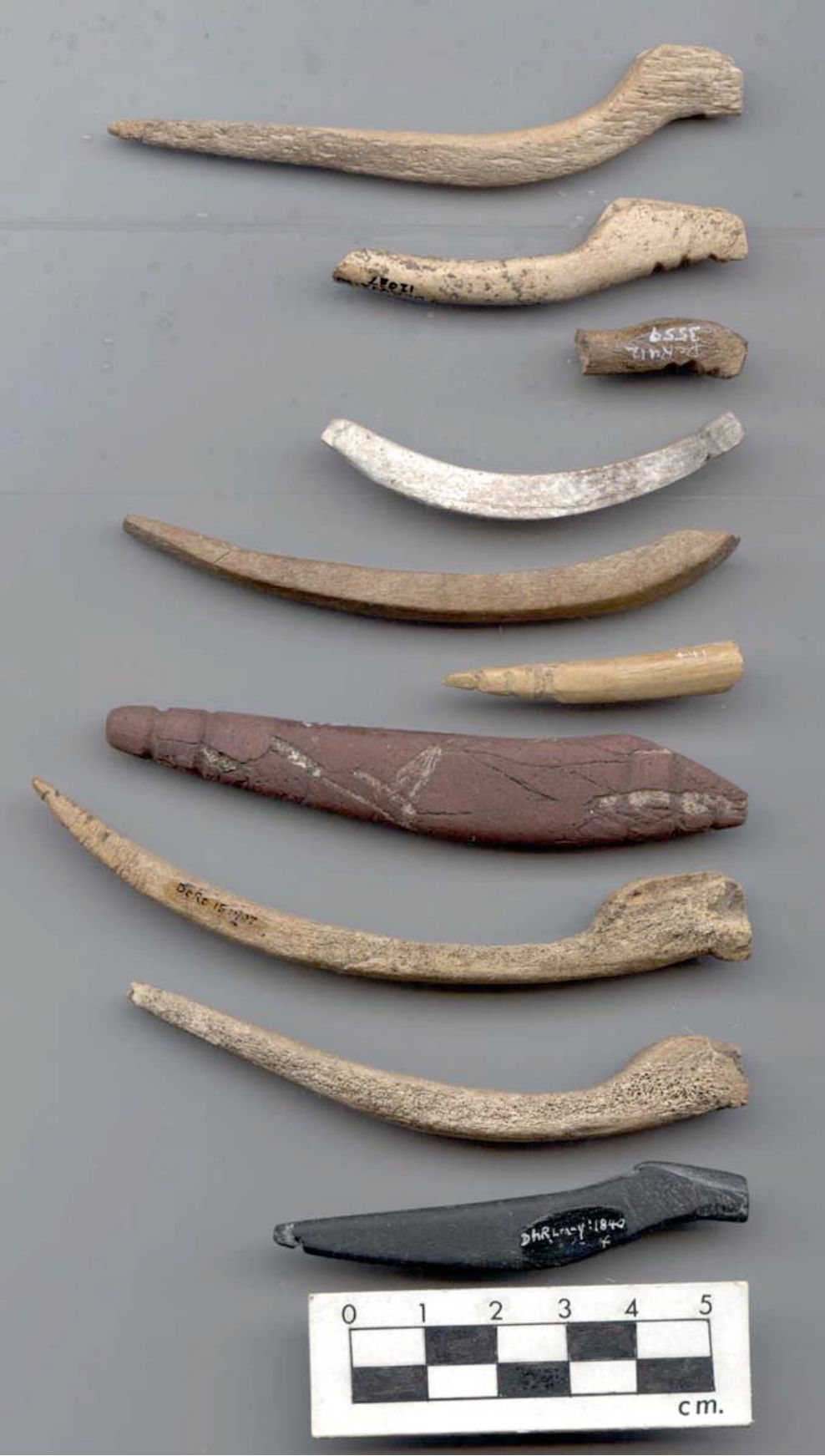
• DcRu-76o:88. Pilgrim Cove. Esquimalt Harbour. Stone. Red shale. 22.2 grams. Max. L. 85mm. Distal hafting platform. L.12.5mm, W. 12mm, H. 12.8mm. Length of platform groove 12.5mm, tie groove area. L. 11.2mm. Proximal end tie groove area 11mm. Midshaft H. 13.4, W. 13.6mm. From Layer c of excavation trench.
• DcRu-12:2914. Maple Bank. Songhees Reserve. Antler. 4.9 grams. Small distal knob missing from base of hafting platform. Max. L. 90mm. Hafting platform: L. 11mm, W. 8mm, H. [11mm]. Proximal tie area has four small notches on ventral surface with traces of grooves extending up one side. Extending 11mm from end. Dated after 1500 years.
• DcRu-1240. Antler. [3.6 ] grams. Missing proximal end. Max. L. [59mm]. Distal hafting platform: L. 19mm, W. 7.1mm, H. 13mm. There are four cut grooves on the dorsal surface of the barb platform. Groove W. 4.2mm. Midshaft: W. 7mm, H, 7.5mm. Dated: after 1500 years.
• DcRu-123559. Antler. [1.1] grams. Only distal platform present. Barb platform L. 9.5mm, W. 8mm, H. 7.5mm. Groove W. 4.5mm. Dated after 1500 years.
• DcRu-78: 22. Fort Rodd Hill. Shell. Purple Hinge Scallop. 3.4 grams. Max. L. 60mm. Flat body suggests that the barb was tied along the side of the distal end rather than in a grooved platform. Midshaft W. 4.5mm, H. 6.5mm. Proximal tie area has one notch encircling the end at 6.5mm distance form tip.
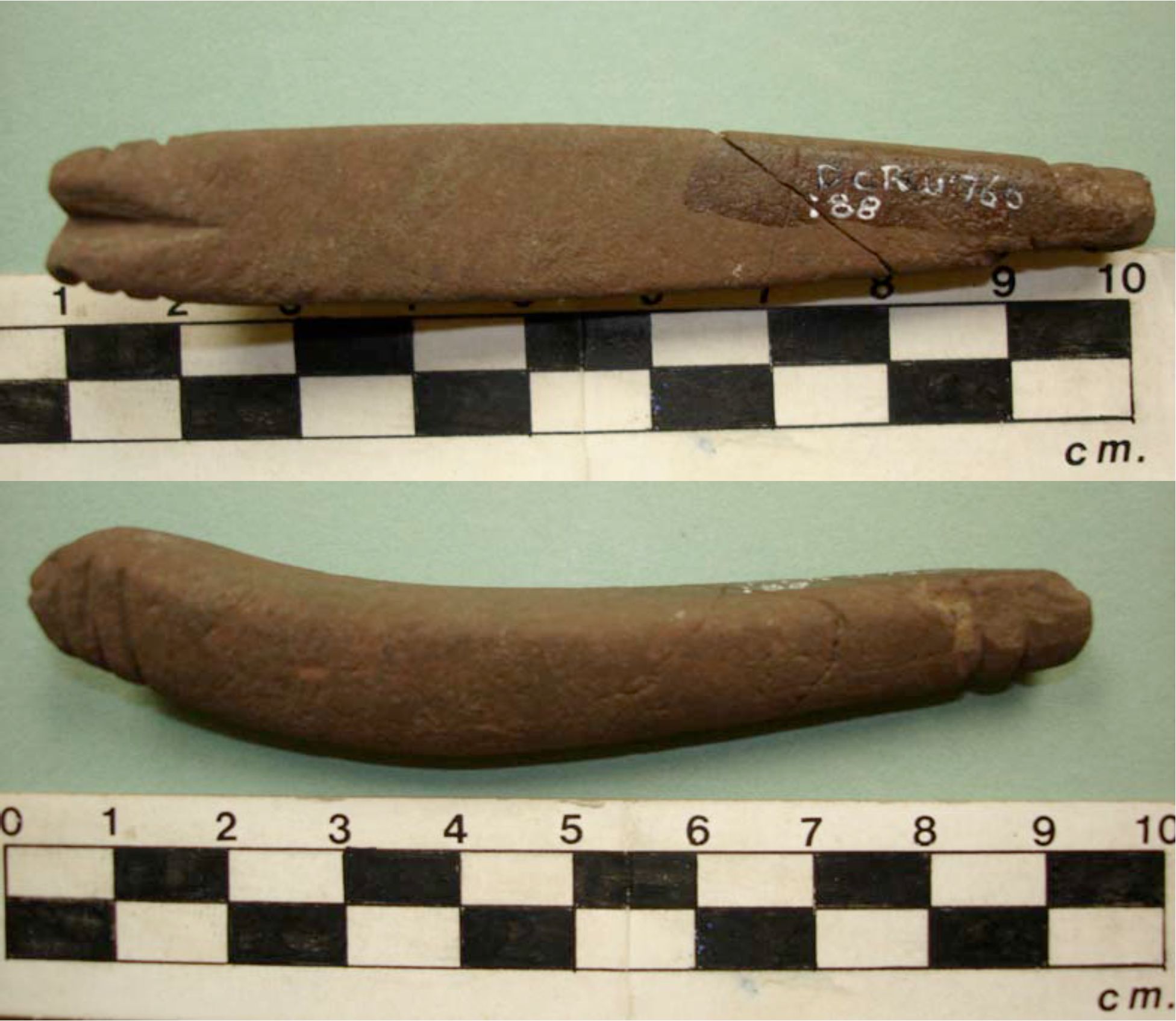
Cadboro Bay
• DcRt-9412. Stone. Red shale. 22.5 grams. Max. L. 92mm. Proximal hafting platform: L. 18.5mm, W. 11mm, H. 16mm. End of platform height 5mm. Groove width 2.1mm. Midshaft: W. 10.5, H. 14.5mm. Proximal end tie area has two encircling grooves extending to 13.5mm from the end. After 1800 years.
• DcRt-15: 907. Antler. 6.6 grams. Max. L. 102mm. Distal hafting platform: L. 21mm, 9.2mm, H. 13mm. Groove width 5mm. Midshaft W. 7mm, H. 6mm. Proximal end tie area has many short incised notches extending 15mm from the end. Age: After 1800 years old.
• DcRt-15: 514. Antler. 5.4 grams. Max. L. 90mm. Distal hafting platform. L. 16mm, W. 9mm, H. 12mm. End of platform height 9mm. Ventral groove width 5mm and depth 4mm. Cut groove on side and base of platform forming 2mm lip. Midshaft W. 6mm, H. 7mm. Proximal end tie area has many short incised notches extending 13mm from the end. Age: After 1900 years old.
Upper Victoria Harbour
• DcRu-116:57. Bone. Weight: 1.93 grams. Complete. Max. L. 60mm. Mid shaft W. 3.5mm; H. 5.3mm. No true platform. Groove across side of upward curving shaft. 2mm Groove, 3mm from end. Distal end has three different sized grooves extending from one side onto the top to a distance of 8mm from the end. Date: after 1600 B.P.
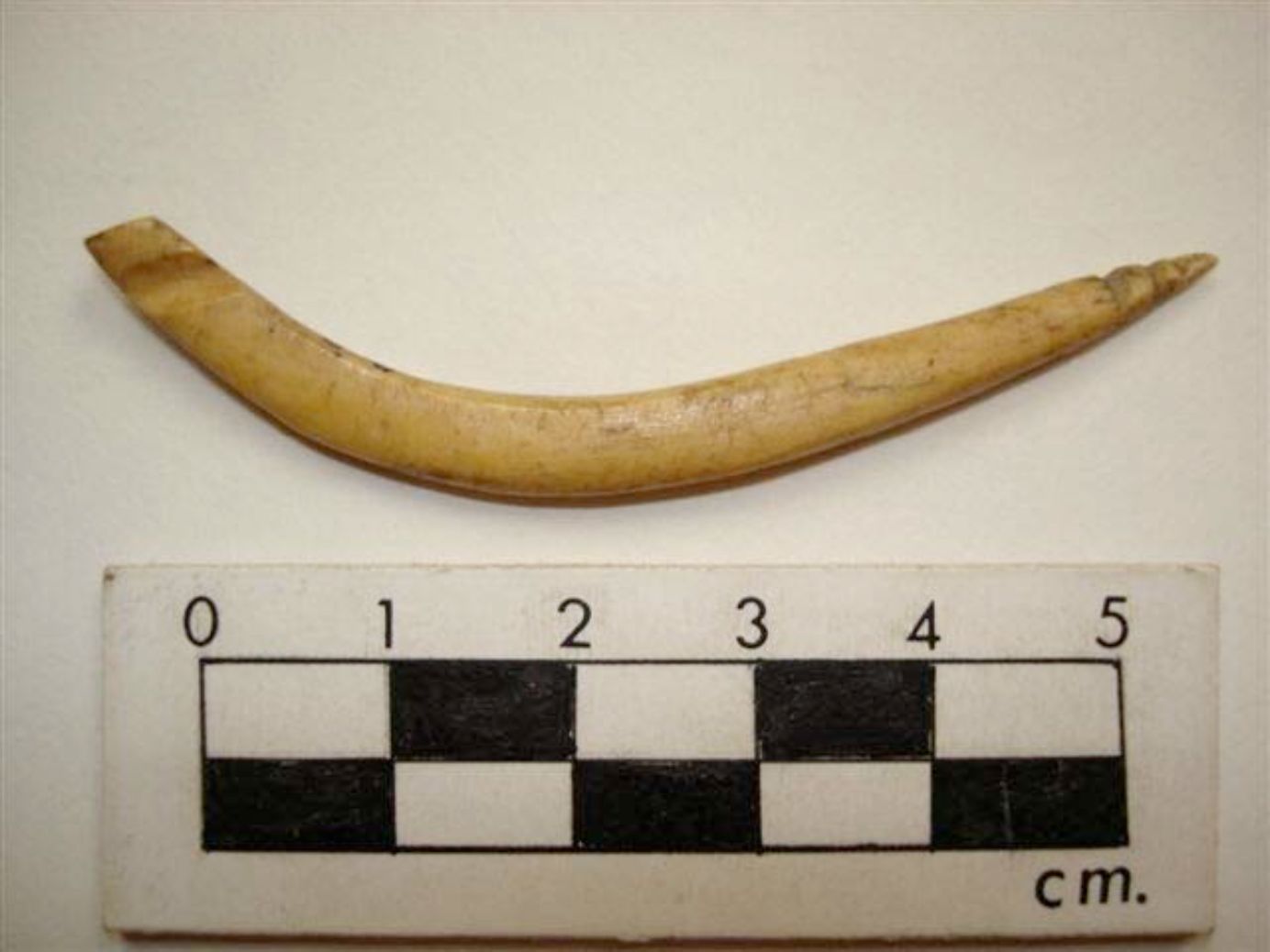
Saanich Peninsula
• DR-Y:224. [old # 9666]. Notes of Charles Newcombe (1933) state: “Found either on Saanich Peninsula or Salt Spring Island. Data lost”. Stone. 9.1 grams. Max. L. 59mm. Distal hafting platform: L. 15mm, W. 7mm, H. 16.5mm, H. distal end 11mm. Groove W. 3mm. Midshaft: W. 7.5mm, H.9mm. Proximal tie area has two grooves around sides and dorsal surface extending to .6mm from end, and 7mm long dorsal groove (figure 4).
• DdRu-4497 Bazan Bay. Stone. Complete. Max. L. 90mm; W. 12mm. (Artifact reburied at site – not in RBCM collection). Illustrated in Plate 4, page 19, in: The North Saanich Sewer Project: Archaeological Monitoring at DdRu4—oo4. Millennia Research Ltd, 2002. Permit 2001-264. Similar to DcRt9:412 with grooves on the side of the distal platform.
• DdRu-4498. Bazan Bay. Stone. Distal portion only. Max. L. [47mm]; Max. W. 12mm. (Artifact reburied at site – not in RBCM collection). Illustrated in Plate 4, page 19, in: The North Saanich Sewer Project: Archaeological Monitoring at DdRu4—004. Millennia Research Ltd, 2002. Permit 2001-264. Similar to DcRt9:412 with grooves on the side of the distal platform.
• DeRu-13088. Bone. [2] grams. Distal end fragment only. Max. L. [40mm]; Max. W. 10mm; max. thickness 10mm. Private Collection.
Nanaimo Area
• DgRw—4:2774. Bone. (0.64) grams. Proximal end and part of shaft only. Max. L. (25mm); Height of platform 8mm; W. 4mm; L. 11mm. Platform groove width 2mm.
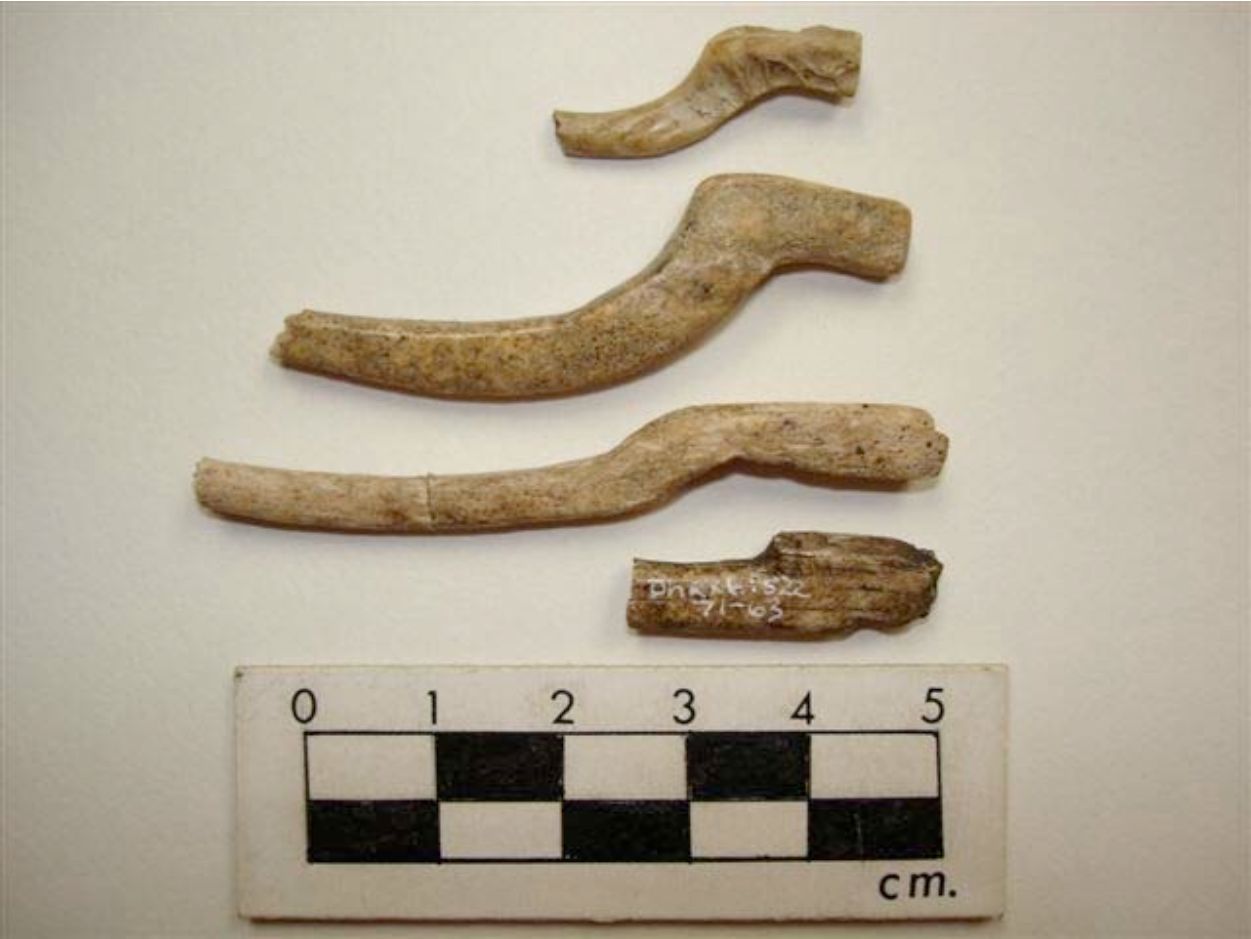
• DgRw-4:287. Antler. (2.12) grams. Distal end missing. Max. L. (50mm). Mid shaft W. 5mm; H. 6mm. Platform H. 6.5mm; W. 7mm; L. 17mm. Platform groove width 4mm.
• DgRw-4:1199. Antler. (1.8) grams. Max. L. (58mm). Mid shaft W. 3mm; H. 3mm. Platform H. 6mm; W. 7mm; L. 21mm.
• DhRx-6:522. Bone. (1.44) grams. Portion of proximal end only. Max. L. (24mm). Platform H. (8mm); W. 5mm; L. (9mm). 2mm groove on base of platform 3mm in from end.
Thetis Island, Chemainus Area
• DfRw-Y:44. [old cat. #5516; old private collection #385]. Sandstone. 9.3 grams. Max. L. 71mm. Missing distal ventral surface up to just past mid shaft area. Midshaft: W. 7 mm. H. [10mm]. Proximal end tie are has 2 grooves encircling both surfaces and sides and extending 10mm from proximal end.
Lower Fraser Valley (Duroche Area – Between Mission and Aggassiz)

• DhRlm-Y:1840. Stone. 6.68 grams. Max. L. 68mm. Proximal hafting platform: L. 16mm, W. 6mm, H. 10mm, H. distal end 7mm. Ventral platform groove: 12mm Midshaft: W. 5mm,H. 6mm. Proximal end has one cut notch on dorsal surface 44mm from end. This shank was from a large private collection that came mostly from the Duroche area, but we can not rule out that this example came from southern Vancouver Island.
